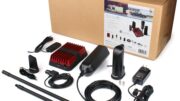So there’s this one guy, and here’s what he wants to do. He wants to take the signals from his satellite system, and rebroadcast them to a bunch of other people in his RV park. Then he wants to charge each person for the service as part of their parking fee.
And here’s the kicker, he wants it to be broadcast wirelessly.
Believe it or not, what he wants to do is legal. It’s called a “headend” system and it’s a perfectly normal way for people to do business. You get a bunch of receivers (or one COM3000 or Smartbox system) and the signal is processed and combined onto a single wire. When it gets to the TV, you can tune to whatever channel you like, sort of like an old-school cable system. In fact, exactly like an old-school cable system.
The issue is when you want to go wireless. It seems like it would be the perfect solution… get a low-power transmission system that puts out the signals you need so that anyone with any TV can just tune to the channel they want. There are just a “few” issues with that.
You need licenses you’ll never get.
You would need a separate broadcast license for every channel, and you won’t get them if the channels are already in use anywhere in the vicinity. There’s actually plenty of broadcast capacity, so that isn’t the problem. The problem is that you’ll pay, oh, about a million dollars for each channel, give or take.
You’ll use a LOT of power.
TV broadcast towers use about 50,000 watts, or as much as 7,500 LED light bulbs burning at the same time. You wouldn’t need that much, but you’d need more than you think because broadcasting uses “the rule of squares.” You lose a lot of your broadcast power in just the first few feet from the tower, so let’s just say you needed 2,000 watts to get each channel out there. Oh, right. You need 25 channels. So you’re right back to 50,000 watts. That’s a heck of an electric bill.
The internet will not save you.
OK so let’s say you want to do this all with Wi-Fi, not with traditional broadcasting. So you need IP encoders, that raises the price of the whole thing up, and then you need to feed the whole thing through large Wi-Fi access points, and you’ll need one for every 4,000 square feet you want to cover, if you want good quality and no dropped connections. Then you’ll need special IPTV boxes, one for each TV, and Wi-Fi adapters that can work with them (and frankly I don’t even know any that would), and then you’ll teach every person in the RV park how to use them and then hope they return the little $100 boxes when they drive away. Chances are they won’t.
Oh, I’m sure there is other stuff to be concerned with but just looking at those factors, you can see there’s an uphill battle going on there.
Right about now, you’re probably pretty depressed thinking that your hopes have been dashed. I don’t blame you. Unfortunately, this sort of thing is actually hard to do for a reason — video broadcasting, using public airwaves, that’s always been a tightly controlled thing and the internet is just not designed for this kind of operation. Believe me, it sounds like a great idea, but like so many… there are just too many obstacles to overcome.
There are better ways
If you’re looking for ways to provide value to people at your RV park, there are better ways than expensive broadcasting. The folks at Signal Connect are experts at helping RV park owners. We have decades of experience with it. If you want your RV park to be special, call the experts! We are here for you during East Coast business hours at 888-233-7563. If it’s after hours, fill out the form below and we’ll get back to you, usually within 24 hours.





